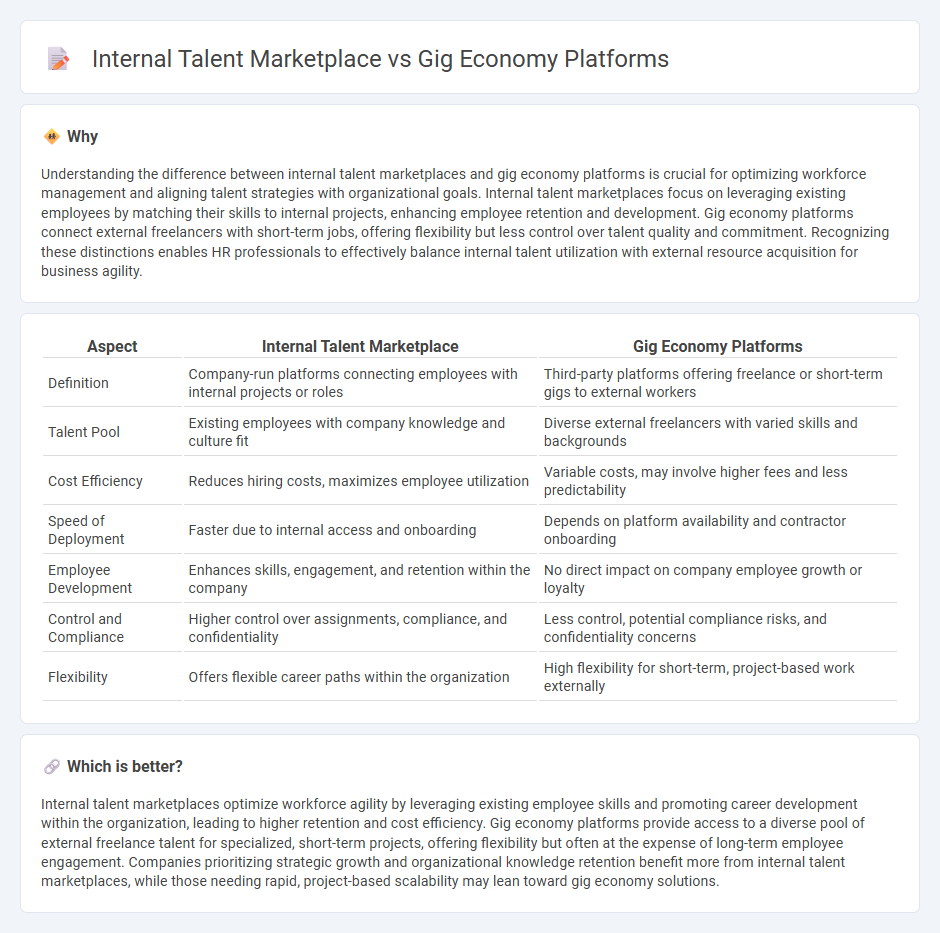
Internal talent marketplaces leverage existing employee skills and company knowledge to efficiently match talent with project needs, enhancing retention and workforce agility. Gig economy platforms connect external freelancers for flexible, on-demand task fulfillment but may lack organizational culture integration and long-term engagement benefits. Explore how these approaches can strategically optimize workforce management and business outcomes.
Why it is important
Understanding the difference between internal talent marketplaces and gig economy platforms is crucial for optimizing workforce management and aligning talent strategies with organizational goals. Internal talent marketplaces focus on leveraging existing employees by matching their skills to internal projects, enhancing employee retention and development. Gig economy platforms connect external freelancers with short-term jobs, offering flexibility but less control over talent quality and commitment. Recognizing these distinctions enables HR professionals to effectively balance internal talent utilization with external resource acquisition for business agility.
Comparison Table
| Aspect | Internal Talent Marketplace | Gig Economy Platforms |
|---|---|---|
| Definition | Company-run platforms connecting employees with internal projects or roles | Third-party platforms offering freelance or short-term gigs to external workers |
| Talent Pool | Existing employees with company knowledge and culture fit | Diverse external freelancers with varied skills and backgrounds |
| Cost Efficiency | Reduces hiring costs, maximizes employee utilization | Variable costs, may involve higher fees and less predictability |
| Speed of Deployment | Faster due to internal access and onboarding | Depends on platform availability and contractor onboarding |
| Employee Development | Enhances skills, engagement, and retention within the company | No direct impact on company employee growth or loyalty |
| Control and Compliance | Higher control over assignments, compliance, and confidentiality | Less control, potential compliance risks, and confidentiality concerns |
| Flexibility | Offers flexible career paths within the organization | High flexibility for short-term, project-based work externally |
Which is better?
Internal talent marketplaces optimize workforce agility by leveraging existing employee skills and promoting career development within the organization, leading to higher retention and cost efficiency. Gig economy platforms provide access to a diverse pool of external freelance talent for specialized, short-term projects, offering flexibility but often at the expense of long-term employee engagement. Companies prioritizing strategic growth and organizational knowledge retention benefit more from internal talent marketplaces, while those needing rapid, project-based scalability may lean toward gig economy solutions.
Connection
Internal talent marketplaces leverage gig economy platforms' principles by enabling employees to access short-term projects and flexible roles within their organization, fostering agility and skill development. These platforms optimize workforce allocation by matching internal talent to immediate business needs, reducing reliance on external hiring. Integrating gig economy dynamics into human resources enhances employee engagement and retention through personalized career growth opportunities.
Key Terms
Flexibility
Gig economy platforms offer unmatched flexibility by enabling workers to select projects based on their schedules and preferences, providing a diverse array of short-term opportunities. Internal talent marketplaces, while offering flexibility, primarily facilitate skill-building and project matching within an organization, balancing employee development with business needs. Explore how each model can drive agility and enhance workforce management in your organization.
Workforce Allocation
Gig economy platforms enable immediate access to a diverse pool of external freelancers, optimizing workforce allocation through flexible, on-demand project staffing. Internal talent marketplaces leverage employee skills and career aspirations within the organization to match internal projects effectively, enhancing retention and reducing external hiring costs. Discover how strategic workforce allocation transforms business agility by exploring deeper insights into gig platforms and internal talent marketplaces.
Talent Mobility
Gig economy platforms facilitate flexible, project-based work by connecting external freelancers with organizations, while internal talent marketplaces enable companies to unlock and optimize their existing workforce for talent mobility. Internal talent marketplaces enhance employee engagement, retention, and skill development by matching internal projects to in-house talent using AI-powered algorithms, whereas gig platforms primarily address immediate, short-term needs. Explore how leveraging internal talent marketplaces can transform talent mobility and drive sustainable workforce agility.
Source and External Links
Upwork - A popular freelance platform connecting professionals with clients across various industries like IT, writing, and design.
Fiverr - Offers a wide range of freelance services, including digital marketing, graphic design, and video creation.
Uber Eats - A food delivery platform that connects customers with restaurants and allows gig workers to deliver using their own vehicles.
Toptal - Focuses on high-end freelancing in fields like software development, finance, and design.
TaskRabbit - Connects local clients with skilled workers for tasks like handyman work and furniture assembly.
Airbnb - An online marketplace for booking unique accommodations, empowering individuals to monetize their properties.
Crowdspring - A platform for creatives to engage in design contests and freelance projects.
DoorDash - A food delivery service providing on-demand job opportunities for gig workers.
Rover - A pet-sitting and dog-walking platform offering flexible work opportunities.
 dowidth.com
dowidth.com